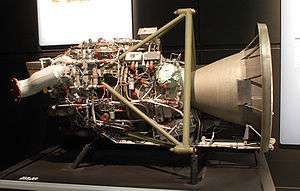Skylark (rocket)
Skylark was a British sounding rocket design. The Skylark was first launched in 1957 from Woomera, Australia and its 441st and final launch took place from Esrange, Sweden on 2 May 2005. Launches had been carried out from sites in Europe, Australia, and South America, with use far beyond the UK by NASA, the European Space Research Organisation (ESRO), and German and Swedish space organizations.[1]
History
The design first dates to 1955, when initial work was carried out by the Royal Aircraft Establishment at Farnborough and the Rocket Propulsion Establishment at Westcott. The first vehicles were ready less than two years later, and sent for testing to Woomera during the International Geophysical Year.
During the 1960s Skylark evolved into an excellent platform for space astronomy, with its ability to point at the Sun, Moon, or a star. It was used to obtain the first good-quality X-ray images of the solar corona.[2] Within the UK national programme, the frequency of Skylark launches peaked at 20 in 1965 (from Woomera), with 198 flights between 1957 and 1978.[2]
The first X-ray surveys of the sky in the Southern Hemisphere were provided by Skylark launches.[2] It was also used with high precision in September and October 1972 in an effort to locate the optical counterpart of X-ray source GX3+1 by lunar occultation.[2]
In 1975, The Federal Republic of Germany through the DFVLR (now German Aerospace Center or DLR) agreed with Australia to launch a Skylark rocket at Woomera for scientific purposes.[3] The launch took place on 14 March 1975. This was followed by three more, launched on 22 February, 13 March 1979,[4] and 24 August 1987.[5][6]
Skylarks were built in some numbers into the 1970s, until the UK government decided to end the programme in 1977, thinking that future "low weight" research would be carried out on the Space Shuttle instead. The programme was handed to British Aerospace, who later sold it to Matra Marconi Space, who in 1999 in turn sold it to a small private company, Sounding Rocket Services, based in Bristol.
Description
The basic Skylark is 7.6 metres (25 ft) long, 0.44 metres (17 in) in diameter and has a fin span of 0.96 metres (38 in). Booster stages can increase the height to 12.8 metres (42 ft). The original version was propelled by 840 kilograms (1,850 lb) of solid fuel, which enabled 45 kilograms (99 lb) to be launched to an altitude of over 200 kilometres (120 mi). Improvements were made to the engine and the use of a booster increased the payload to 200 kilograms (440 lb) in 1960. Skylark 12, from 1976, could lift 200 kilograms (440 lb) to 575 kilometres (357 mi) altitude.
Due to its small mass and low thrust, the original version of the Skylark had to be launched from a 25 metres (82 ft) tilting tower to overcome the effects of the wind. Later versions only required a simple trailer.
Survivors
Skylark Rockets are on display in the following locations:
- University of Leicester, Department of Physics and Astronomy. (Skylark Raven (c. 1957))
- National Space Centre in Leicester. (Skylark Goldfinch Raven)
- Mullard Space Science Laboratory, Surrey, England. (Skylark 7 (Goldfinch II, Raven XI))
- Rocketry Museum, Woomera, Australia (Skylark Nosecone only)
- Woomera Missile Park, Woomera, Australia (Cuckoo, Raven)
- The Euro Space Center in Belgium (replica)
- Aerospace Bristol, Filton, Bristol, England.
- In the possession of Mexborough & Swinton Astronomical Society in South Yorkshire, England.
- Solna strandvag 86, Stockholm, Sweden. (Partly viewable from the waterfront)
See also
References
Notes
- ↑ Matthew Godwin (Jan 2008). The Skylark Rocket: British Space Science and the European Space Research Organisation, 1957–1972. Paris: Beauchesne Editeur.
- 1 2 3 4 Pounds K (2002). "Forty years on from Aerobee 150: a personal perspective". Philosophical Transactions of the Royal Society A. 360 (1798): 1905–21. Bibcode:2002RSPTA.360.1905P. doi:10.1098/rsta.2002.1044. PMID 12804236.
- ↑ “Exchange of Notes constituting an Agreement between the Government of Australia and the Government of the Federal Republic of Germany concerning the Launching of a Skylark Vehicle and Payload at Woomera for Scientific Purposes. ATS 6 of 1975”. Australasian Legal Information Institute, Australian Treaties Library. Retrieved on 20 April 2017.
- ↑ “Exchange of Notes constituting an Agreement between the Government of Australia and the Government of the Federal Republic of Germany concerning the Launching of Two Scientific Payloads from Woomera for Scientific Purposes. ATS 3 of 1979”. Australasian Legal Information Institute, Australian Treaties Library. Retrieved on 15 April 2017.
- ↑ “Exchange of Notes constituting an Agreement between the Government of Australia and the Government of the Federal Republic of Germany on the Launching of Sounding Rockets. ATS 12 of 1987”. Australasian Legal Information Institute, Australian Treaties Library. Retrieved on 15 April 2017.
- ↑ "Germany". www.astronautix.com. nautica. Retrieved 19 April 2017.
Bibliography
- Robin H. Brand (2014). Britain's First Space Rocket – The story of the Skylark (1st ed.). YPD Books. ISBN 978-0-9929896-0-6.
External links
| Wikinews has related news: British Skylark rocket makes its final flight |

